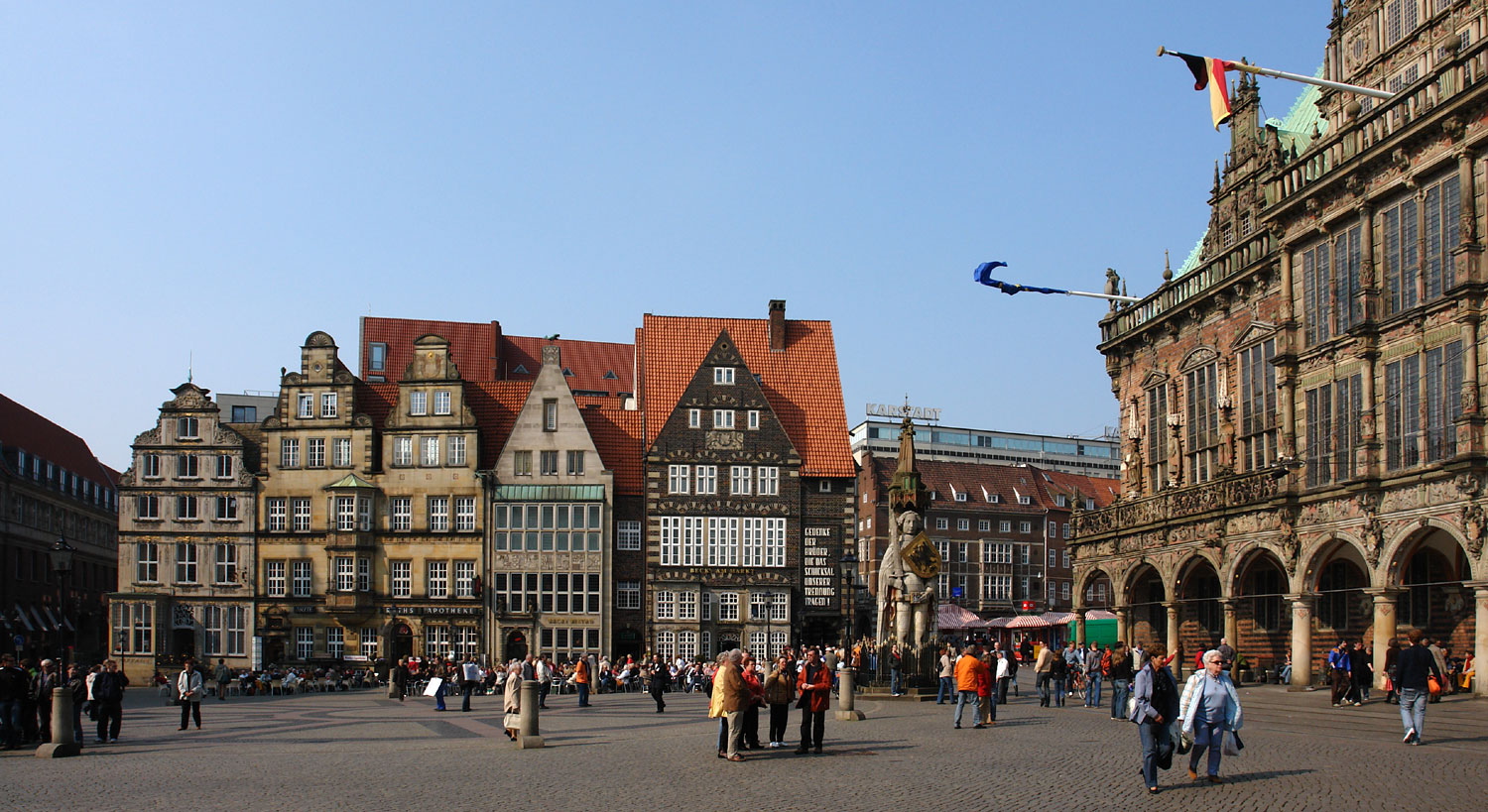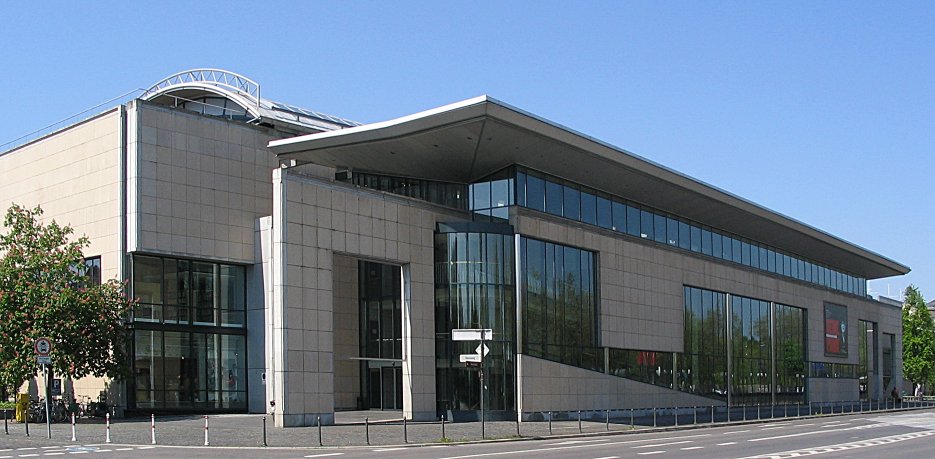|
Rathscafé (Bremen)
The old Rathscafé (Town Council Café), now named Deutsches Haus, is a listed building on the market place ('' Marktplatz'') in Bremen. It is part of the monument ensemble No. 1–21. History In the Middle Ages, a municipal wine-house was situated on the corner of Bremer Marktplatz/ Liebfrauenkirchhof and Obernstrasse. Later on, the building was redecorated with a Renaissance gable. Until the 17th century, the building was used as a wine warehouse. Later on it passed into private ownership and was remodeled on several occasions. In 1900, it was used as a lingerie store. Thereafter, it was purchased by the city and demolished to provide space for a new building. Rathscafé As the building was situated in the immediate neighbourhood of the Town Hall, it was decided to launch an architectural competition to attract bids for its reconstruction from throughout Germany. The competition was won by the young Bremen architect Rudolf Jacobs. In accordance with his designs, it was ... [...More Info...] [...Related Items...] OR: [Wikipedia] [Google] [Baidu] |
Acanthus (ornament)
The acanthus () is one of the most common plant forms to make foliage ornament and decoration in the architectural tradition emanating from Greece and Rome. Architecture In architecture, an ornament (art), ornament may be carved into stone or wood to resemble leaves from the Mediterranean species of the ''Acanthus (plant), Acanthus'' genus of plants, which have deeply cut leaves with some similarity to those of the thistle and poppy. Both ''Acanthus mollis'' and the still more deeply cut ''Acanthus spinosus'' have been claimed as the main model, and particular examples of the motif may be closer in form to one or the other species; the leaves of both are, in any case, rather variable in form. The motif is found in decoration in nearly every medium. The relationship between acanthus ornament and the acanthus plant has been the subject of a long-standing controversy. Alois Riegl argued in his ''Stilfragen'' that acanthus ornament originated as a sculptural version of the palmette, ... [...More Info...] [...Related Items...] OR: [Wikipedia] [Google] [Baidu] |
Georg Dehio
Georg Gottfried Julius Dehio (22 November 1850 – 21 March 1932), was a Baltic German art historian. In 1900, Dehio started the "''Handbuch der deutschen Kunstgeschichte''" (Handbook of German Art History), published by Ernst Wasmuth Verlag, Ernst Wasmuth. The project is ongoing and managed by the 'Dehio-Vereinigung', Munich. He gave his name to the Georg Dehio Prize (Georg Dehio Book Prize). Dehio was born in Reval (Tallinn), then part of the Russian Empire. He died in Tübingen, Germany. He was laureate of the Pour le Mérite order (Pour le Mérite, "Pour le Mérite für Wissenschaften und Künste"), the Eagle Shield of the German Empire (Adlerschild des Deutschen Reiches) and the Bavarian Maximilian Order for Science and Art. He held honorary doctor titles in Göttingen, Tübingen, Frankfurt (Main) and Darmstadt. The minor planet 48415 Dehio discovered circa 1987, is named after him. See also * Karl Gottfried Konstantin Dehio (27 May 1851, Reval (Tallinn) – 26 Februa ... [...More Info...] [...Related Items...] OR: [Wikipedia] [Google] [Baidu] |
Das Große Bremen-Lexikon
''Das Große Bremen-Lexikon'' is an 18th-century encyclopaedia by the Freie Hansestadt Bremen, written by Herbert Schwarzwälder about * the region, as Territory of Bremen, as Prince-Archbishopric of Bremen (Bremen Archbishopric), as Bremen-Verden and * an encyclopaedia of the Hanseatic city Bremen and the maritime city Bremerhaven.. History In Bremen, ''Brema literata'' was published anonymously in 1709 by Heinrich Iken. The fourth edition was last published in an adaptation by in 1726. In the work were reported gossips by writers and scholars. Around 1765 the started with a work ''Bremisch-Niedersächsisches Wörterbuch''. The work appeared from 1767 to 1772 in five volumes as a regional encyclopaedia. Words, terms and cultural-historical topics were treated. In 1818, the ''Lexikon aller Gelehrten'' by the cathedral pastor was published as an encyclopaedic collection of biographers. From 1961 to 1965, the '' Weser-Kurier'' published as a book a ''Kleines Bremer Lexikon' ... [...More Info...] [...Related Items...] OR: [Wikipedia] [Google] [Baidu] |
Haus Der Stadtsparkasse (Bremen)
Haus der Stadtsparkasse (Stadtsparkasse Building) is a Rococo architecture, Rococo landmark on the "Bremer Marktplatz, Marktplatz" (Market Square) in Bremen, Germany. It was completed in the 1950s combining the historic front gable from another site with the more recent architecture of the remainder of the building. History In 1755, Johann Georg Hoffschlaeger, a wine merchant and city counsellor, had a house built on a site now designated as No. 31B, An der Schlachte. The stonemason Theophilus Wilhelm Frese (1696–1763) decorated the façade in the Rococo style, with a bow window and a gable topped with a wig. In 1836, the building was bought by Georg Friedrich Pflüger who used it as an inn named ''Stadt Paris'' (City of Paris). In 1875, the property was taken over by Carl Wilhelm Meyer, a publicly appointed sampler. In the early 20th century, a new building designed by Albert Dunkel maintained the Rococo façade. The building was destroyed in the World War II, second worl ... [...More Info...] [...Related Items...] OR: [Wikipedia] [Google] [Baidu] |
Raths-Apotheke (Bremen)
The Raths-Apotheke (literally: Council Apothecary) is a listed building on the Market Square ('' Marktplatz'') in Bremen, Germany. After suffering war damage, the building was restored with two gables in the Neobaroque style in 1958, re-establishing the square's sequence of gabled buildings dating from the 1820s. History There has been a Raths-Apotheke in Bremen since 1510. The exact location of the original building is not known but it was probably situated in Sögestrasse. It is first mentioned in a document from 1 October 1532 in which the city requires the pharmacist to sell his wares at fair prices. The pharmacist received his income from the city council. From the 17th century, the council leased the pharmacy for 10 years at a time, later for life. The supervision was ensured by the third mayor and by a councillor. From 1594 to 1820, two beautiful three-storey gabled buildings in the Weser Renaissance style stood of the site of today's Raths-Apotheke. Differing i ... [...More Info...] [...Related Items...] OR: [Wikipedia] [Google] [Baidu] |
Coat Of Arms Of Bremen
The Bremen (state), Free Hanseatic City of Bremen is a state, and Bremen is a city, in Germany. Description The coat of arms of the Free Hanseatic City of Bremen shows a Argent, silver key on a Gules, red shield. The key is the attribute of Saint Peter, Simon Petrus, patron saint of the Bremen Cathedral, and it was first represented in the seal of the City of Bremen in 1366, after its liberation from the occupation by Prince-Archbishop Albert of Brunswick and Lunenburg-Wolfenbüttel, Albert II, and later became the main element of the city's coat-of-arms. History Bremen's red and white colors derive from the colors of the Hanseatic League. Starting in the 16th century, the shield was supported by angels, but from 1568, however, they were replaced by lions. In 1617 a helmet was added, but it was never officially part of the coat of arms. The crown on the coat of arms dates from the late 16th century. In 1811, Napoleon Bonaparte added three bees to the coat of arms. The bees were ... [...More Info...] [...Related Items...] OR: [Wikipedia] [Google] [Baidu] |
Bonn
Bonn () is a federal city in the German state of North Rhine-Westphalia, located on the banks of the Rhine. With a population exceeding 300,000, it lies about south-southeast of Cologne, in the southernmost part of the Rhine-Ruhr region. This metropolitan area, Germany's largest, is also the second largest in the European Union by GDP, with over 11 million residents. Bonn served as the capital of West Germany from 1949 until 1990 and was the seat of government for reunified Germany until 1999, when the government relocated to Berlin. The city holds historical significance as the birthplace of Germany's current constitution, the Basic Law. Founded in the 1st century BC as a settlement of the Ubii and later part of the Roman province Germania Inferior, Bonn is among Germany's oldest cities. It was the capital city of the Electorate of Cologne from 1597 to 1794 and served as the residence of the Archbishops and Prince-electors of Cologne. The period during which Bonn was ... [...More Info...] [...Related Items...] OR: [Wikipedia] [Google] [Baidu] |
Haus Der Geschichte
Haus der Geschichte (officially ''Haus der Geschichte der Bundesrepublik Deutschland'', i.e. "House of the History of the Federal Republic of Germany") is a museum of contemporary history in Bonn, Germany. With around one million visitors every year, it is one of the most popular German museums. The Haus der Geschichte is part of the ''Haus der Geschichte der Bundesrepublik Deutschland Foundation'', alongside the " Zeitgeschichtliches Forum Leipzig", the " Tränenpalast" at Berlin Friedrichstraße station and the " Museum in the Kulturbrauerei". The foundation's headquarters is in Bonn. In its permanent exhibition, the Haus der Geschichte presents German history from 1945 until the present. Numerous temporary exhibitions emphasize different features. The Haus der Geschichte also organizes guided tours of the Palais Schaumburg (has been closed since August 2013 because of building restoration), the Chancellor's bungalow and the former place of the Federal Assembly. Moreover, t ... [...More Info...] [...Related Items...] OR: [Wikipedia] [Google] [Baidu] |
Wilhelm Kaisen
Carl Wilhelm Kaisen (22 May 1887 – 19 December 1979) was a German politician from the Social Democratic Party of Germany (SPD) who served as the 2nd President of the Senate and Mayor of Bremen from 1945 to 1965. In 1958/59 he served as the 10th President of the Bundesrat. He became a symbolic figure of the German reconstruction in Bremen after 1945. Biography Kaisen was born in the German city of Hamburg, and spent his youth there. His family's poverty did not allow him to visit a higher school or even receive a high school education. In 1905 he became a member of the SPD. After World War I, he moved to his wife's home city of Bremen. Influenced by his family, he got the SPD into the parliament of Bremen (Bürgerschaft). From 1919 to 1928 he was a journalist and editor-in-chief of the SPD newspaper '. From 1920 to 1928 he was member of the Bürgerschaft. In 1928, Kaisen became the SPD Senator of Social Services in the Senate of Bremen. In March 1933, he was pressured to r ... [...More Info...] [...Related Items...] OR: [Wikipedia] [Google] [Baidu] |
East Germany
East Germany, officially known as the German Democratic Republic (GDR), was a country in Central Europe from Foundation of East Germany, its formation on 7 October 1949 until German reunification, its reunification with West Germany (FRG) on 3 October 1990. Until 1989, it was generally viewed as a communist state and described itself as a Socialist state, socialist "workers' and peasants' state". The Economy of East Germany, economy of the country was Central planning, centrally planned and government-owned corporation, state-owned. Although the GDR had to pay substantial war reparations to the Soviets, its economy became the most successful in the Eastern Bloc. Before its establishment, the country's territory was administered and occupied by Soviet forces following the Berlin Declaration (1945), Berlin Declaration abolishing German sovereignty in World War II. The Potsdam Agreement established the Soviet occupation zone in Germany, Soviet-occupied zone, bounded on the east b ... [...More Info...] [...Related Items...] OR: [Wikipedia] [Google] [Baidu] |





